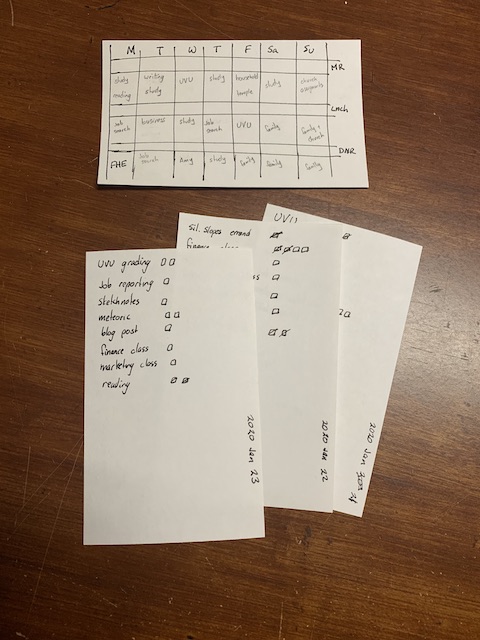Simple planning

I’ve had a number of people ask “How do you get so much done?” For a long time I just shrugged my shoulders and said, “I’m organized?” However, it hasn’t been until recently that I have worked on unpacking just exactly what it is I do that helps me get as much done as I do. One of the best ways I have found that helps me stay focused in keeping a list of things I want to do during the day.
It is NOT a task/todo list.
It is instead a well conceived plan, that is formulated the night before, written down on an index card I keep to the side of my computer, along with my weekly schedule template. I do this for a couple of reasons.
Writing it down engrains it into your mind and then you also have something to look at the next day when you walk into the room and take a look at your desk. That piece of paper gets you going and you know exactly what you are going to focus on for the day.
Another reason is that the piece of paper is disposable and temporary. It is my plan for the day, but if something comes up I can change that plan.
Finally, it is different from the todo list I have on all my devices. It is the plan and may have some things from the todo list on it, but it is just an idea of what to do for today to reach my goals. Nothing more or less. The todo list on the computer is a project management tool. The index card is the marching orders for the day.
Another thing that helps is time boxing your activities. Other people have named it other things, one of the most popular is the “pomodoro technique,” but the idea is simple. You set up a specific amount of time that you will focus on a task. Set a timer for that amount of time and then when the time is up, you get up from your desk and take a short break. If the task will take a longer amount of time than one of those time box limits, then come back to it and work on it some more until the task is done or the day is done. Which ever comes first.
I combine the two techniques.
The night before I make a list of the things I want to get done. Then, next to each activity I put a square indicating the number of time boxes I will allocate to each of those activities. When I have done the maximum number of those boxes, I have a choice. I can take a box from another task, or move on to the next task. At the end of the day I can then review the list of activities and if I still had one that was not complete, then I can decide what to do with it. Do I abandon it? Work on it more the next day? Put it off for another time? I choose, but there is no guilt because I have made a conscious effort and it is what I decided and planned to do before hand.
Is it a perfect system? No. There are times when events get out of control and the whole plan is worth less than the paper it is written on. I just regroup and try again the next day, with the understanding that I can choose what to work on and it is a complete reset again. As long as some progress is made, then I am good.
If no progress was made on anything, then that means I need to go a little deeper in my personal reflection and decide if what took over the plan was worth it. Sometimes it is, other times it is not. But thankfully there is always tomorrow.
The image is a copy of some of my planning cards from this last week.

Comments